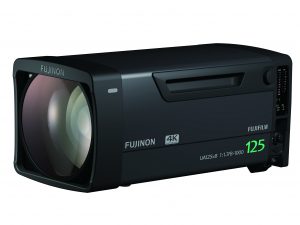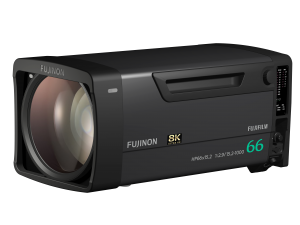Fujinon Intros 125x 4K Lens, Enhanced Functionality via ARIA and RBF, and new 8K Options
FUJIFILM North America Corporation took the wraps off of a number of exciting developments from FUJINON, including a 4K lens with a zoom ratio of 125x, two new 8K lenses with 66x and 12x zoom, the first 4K lens with a new Advanced Focus feature, and two new advanced features—ARIA and RBF—that can be used with many of FUJINON’s 4K and 8K ultra-high-definition (UHD) broadcast lenses.
Thomas Fletcher, Director of Marketing, Optical Devices Division, FUJIFILM North America Corporation, says he is excited to have note only the UA125X8BESM (UA125X8) with the world’s highest zoom ratio of 125x but also that it has improved optical stabilization.
“Compared to the 107x it has a five percent wider image, is 11 percent longer, and only cost 2.3 kilograms in weight and an inch longer in length,” he says.

Fujinon’s latest 4K box lens can offer up to 125x zoom.
The UA125X8 box lens covers a focal length from the wide-angle of 8mm~1000mm, with an F1.7 aperture. It is now the longest and widest 4K field lens for Ultra HD applications in the Fujinon UA series.
“This new UA125x zoom has everything on a producer’s wish list for long-distance 4K UHD shooting,” says Fletcher. “With its high resolution, high contrast, high dynamic range and our improved optical image stabilization technology, the UA125x captures pristine, rock-steady 4K UHD shots. It can do so at great distances but also features a surprising field of view on the wide end. With an aperture F no. of 1.7, virtual reality connections, and 16-bit encoders, the UA125x8 will soon become the standard for 4K UHD and HD production worldwide. We’re very excited for people to see what this lens can do.”
Another new 4K introduction was the UA107x8.4 AF (Advanced Focus) 4K broadcast lens, the world’s first 4K box lens that features the Advanced Focus function.
The UA107x8.4 AF incorporates a newly developed phase-detection auto focus sensor. “It enables some great advantages like faster response rate, better accuracy and stability and improved ability focus detection,” says Stosh Durbacz, Fujinon Canadian Sales Manager.
Focus response speed is as fast as 0.45 seconds and boasts an outstanding capability in tracking a moving subject, including the ability to stay in focus on a person or object that passes behind another object. The lens also features the company’s proprietary image stabilization mechanism and a 107x ultra-magnification zoom that covers focal lengths from 8.4mm to 900mm (1800mm with 2x).
According to Dylan Kissel, a student at Michigan State University and sports camera operator for Spartan Vision, who tested the UA107X AF, “It was a really nice being able to just shoot whatever I wanted to and not have to worry about focus,” he says. “I could whip up to somewhere in the crowd and get the shot, trusting that focus would be there and know I could get back to the game in time. By the end of the first time out, I was very comfortable with it all. I knew the lens was going to take care of me while I got the shots I needed. I didn’t have to worry about taking those extra few seconds to get the focus, and the director didn’t have to worry about it either because he knew it was going to be there and could take my shot.”

Fujinon’s new HP66X15.2ESM has a zoom range of 66x.
The wraps were also taken off of two new 8K lenses: the HP66X15.2ESM (HP66X15.2) box lens which the company says has the world’s longest 8K focal length of 1,000mm while also featuring the world’s highest zoom magnification of 66x; and the HP12X7.6ERD (HP12X7.6) portable lens covering a range of 7.6mm to 91mm, which Fujinon says is the world’s widest 8K angle of view at 93.3 degrees. The lenses are due to be released in the summer of 2020 and the fall of 2020, respectively.
The HP66X15.2 and HP12X7.6 ultra-high-definition (UHD) lenses feature bayonet mounts targeting three 1.25-inch sensors for ultra-high 8K resolution. The HP66X15.2 also features the latest high-performance optical image stabilization mechanism to make 8K production at long focal lengths rock steady. Both lenses can be used with the latest generation of focus accessories to achieve the advanced level of focusing precision that 8K demands.
New Features, New Possibilities
Also introduced today are two new features, ARIA (Automatic Restoration of Illumination Attenuation) and RBF (Remote Back Focus) and both new features will operate with several of Sony’s latest series of 4K UHD cameras.
The ARIA technology works through a sharing of lens design characteristics and positional metadata between the FUJINON broadcast lens and the camera. In the optical design of broadcast lenses, engineering trade-offs must be made to provide desirable zoom ratios at usable size and weight. As a result of these compromises, two major optical phenomena have always existed, exposure ramping at the telephoto end of the zoom and relative illumination. The ARIA feature eliminates both.
“With ARIA the ramping curve designed into the lens is shared with the camera, so the camera adds gain as you zoom in,” says Durbacz. With the camera introducing the appropriate amount of gain it seamlessly counters the darkening of the image, resulting in consistent exposure level throughout the zoom range of the lens.
The second phenomenon is known as relative illumination, a result of all lenses being slightly brighter in their “sweet spot” at the center than at the edge of the image. In instances when this is visible, it is often referred to as corner shading or portholing. Again, here, the relative illumination characteristic of the lens is known and consistent between all serial numbers of a given model. With ARIA turned on, the lens communicates with the camera, providing relative illumination data throughout the full range of the lens, which then corrects the corner shading, giving the picture a consistent, flat illumination from the center to the edges of the image.
Remote Back Focus could prove to be an important new feature, especially if sports productions embrace remote workflows where the production team is separated by greater distances. All broadcast lenses require a calibration of the lens to the camera sensor to ensure proper performance. This calibration, commonly known as back focus, is currently a manual adjustment typically performed locally by a camera operator or technician.
Most of Fujinon’s 4K and 8K broadcast lenses feature what is known as a “Floating Back Focus” system, whereby a servo motor is used when setting back focus. The unique, new RBF feature is operated solely by the video operator in the production truck or control room via the camera RCP and does not require that anyone be at the camera position.
“They can set that from a control room where they have high-end monitors and the ability to really lock it in,” says Durbacz. The video operator has complete control of the zoom, servo focus, and back focus functions of the lens from the standard camera RCP and back focus can now be set at any time or place, even when the camera operator is not available, if the lens is not accessible by a person, or if it is not safe to access the lens.
Here is a breakdown of the features and which Fujinon lenses will have which feature:
ARIA
4K Box Lenses: UA27x6.5, UA70x8.7, UA80x8, UA107x8.4, UA107x8.4 AF and UA125x8
4K Portable Lenses: UA13x4.5, UA14x4.5, UA18x5.5, UA18x7.6, UA22x8, UA23x7.6, UA24x7.8, UA46x9.5 and UA46x13.5
8K Box Lens: HP66x15.2 (Based upon the future lens introduction schedule)
8K Portable Lens: HP12x7.6 (Based upon the future lens introduction schedule)
RBF
4K Box Lenses: UA27x6.5, UA70x8.7, UA80x8, UA107x8.4, UA107x8.4 AF and UA125x8
4K Portable Lenses: UA13x4.5, UA22x8, UA24x7.8 (Fall 2020), UA46x9.5 and UA46x13.5
8K Box Lens: HP66x15.2 (Based upon the future lens introduction schedule)
8K Portable Lens: HP12x7.6 (Based upon the future lens introduction)
For more information on Fujifilm, please contact Gordon Tubbs at [email protected].
